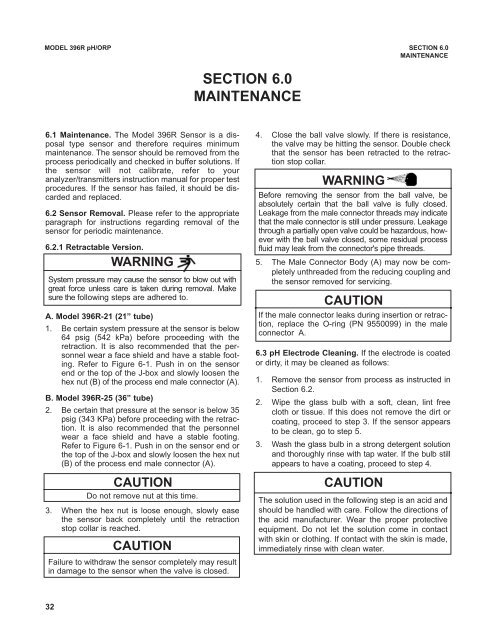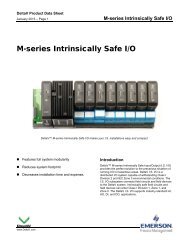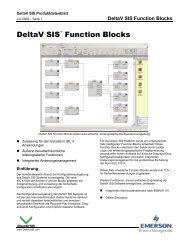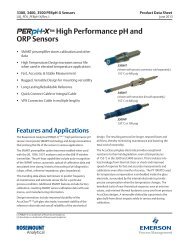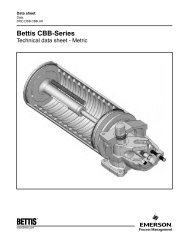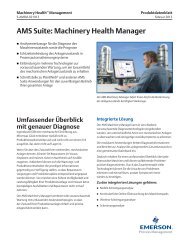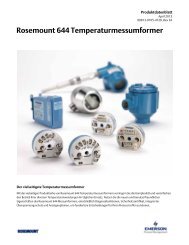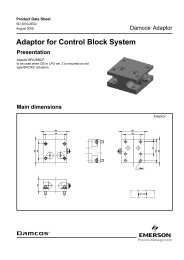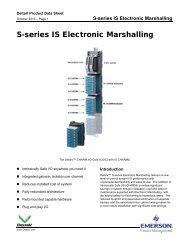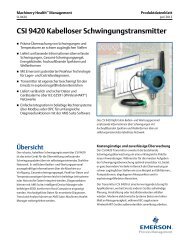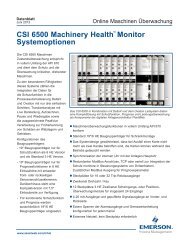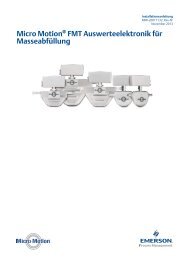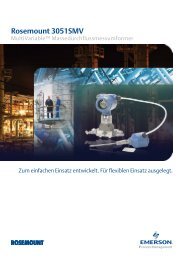Retractable pH/ORP Sensors - Emerson Process Management
Retractable pH/ORP Sensors - Emerson Process Management
Retractable pH/ORP Sensors - Emerson Process Management
Create successful ePaper yourself
Turn your PDF publications into a flip-book with our unique Google optimized e-Paper software.
MODEL 396R <strong>pH</strong>/<strong>ORP</strong> SECTION 6.0<br />
MAINTENANCE<br />
6.1 Maintenance. The Model 396R Sensor is a disposal<br />
type sensor and therefore requires minimum<br />
maintenance. The sensor should be removed from the<br />
process periodically and checked in buffer solutions. If<br />
the sensor will not calibrate, refer to your<br />
analyzer/transmitters instruction manual for proper test<br />
procedures. If the sensor has failed, it should be discarded<br />
and replaced.<br />
6.2 Sensor Removal. Please refer to the appropriate<br />
paragraph for instructions regarding removal of the<br />
sensor for periodic maintenance.<br />
6.2.1 <strong>Retractable</strong> Version.<br />
WARNING<br />
System pressure may cause the sensor to blow out with<br />
great force unless care is taken during removal. Make<br />
sure the following steps are adhered to.<br />
A. Model 396R-21 (21” tube)<br />
1. Be certain system pressure at the sensor is below<br />
64 psig (542 kPa) before proceeding with the<br />
retraction. It is also recommended that the personnel<br />
wear a face shield and have a stable footing.<br />
Refer to Figure 6-1. Push in on the sensor<br />
end or the top of the J-box and slowly loosen the<br />
hex nut (B) of the process end male connector (A).<br />
B. Model 396R-25 (36” tube)<br />
2. Be certain that pressure at the sensor is below 35<br />
psig (343 KPa) before proceeding with the retraction.<br />
It is also recommended that the personnel<br />
wear a face shield and have a stable footing.<br />
Refer to Figure 6-1. Push in on the sensor end or<br />
the top of the J-box and slowly loosen the hex nut<br />
(B) of the process end male connector (A).<br />
32<br />
CAUTION<br />
Do not remove nut at this time.<br />
3. When the hex nut is loose enough, slowly ease<br />
the sensor back completely until the retraction<br />
stop collar is reached.<br />
CAUTION<br />
Failure to withdraw the sensor completely may result<br />
in damage to the sensor when the valve is closed.<br />
SECTION 6.0<br />
MAINTENANCE<br />
4. Close the ball valve slowly. If there is resistance,<br />
the valve may be hitting the sensor. Double check<br />
that the sensor has been retracted to the retraction<br />
stop collar.<br />
WARNING<br />
Before removing the sensor from the ball valve, be<br />
absolutely certain that the ball valve is fully closed.<br />
Leakage from the male connector threads may indicate<br />
that the male connector is still under pressure. Leakage<br />
through a partially open valve could be hazardous, however<br />
with the ball valve closed, some residual process<br />
fluid may leak from the connector's pipe threads.<br />
5. The Male Connector Body (A) may now be completely<br />
unthreaded from the reducing coupling and<br />
the sensor removed for servicing.<br />
CAUTION<br />
If the male connector leaks during insertion or retraction,<br />
replace the O-ring (PN 9550099) in the male<br />
connector A.<br />
6.3 <strong>pH</strong> Electrode Cleaning. If the electrode is coated<br />
or dirty, it may be cleaned as follows:<br />
1. Remove the sensor from process as instructed in<br />
Section 6.2.<br />
2. Wipe the glass bulb with a soft, clean, lint free<br />
cloth or tissue. If this does not remove the dirt or<br />
coating, proceed to step 3. If the sensor appears<br />
to be clean, go to step 5.<br />
3. Wash the glass bulb in a strong detergent solution<br />
and thoroughly rinse with tap water. If the bulb still<br />
appears to have a coating, proceed to step 4.<br />
CAUTION<br />
The solution used in the following step is an acid and<br />
should be handled with care. Follow the directions of<br />
the acid manufacturer. Wear the proper protective<br />
equipment. Do not let the solution come in contact<br />
with skin or clothing. If contact with the skin is made,<br />
immediately rinse with clean water.


